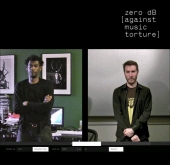Network
- Making sweet virtual music - on a computer
(The Independent, 26th October 1998)
Why bother using a studio, when computer technology is so cheap? By
Hannah Gal
THERE WAS a time when recording an
album meant hiring a studio at a cost of tens of thousands of pounds. Now, in
the age of individualist consumerism, you needn't be in the studio at all -
#2,000 will bring it to your PC.
Latest developments in Virtual
Studio Technology (VST) mean that you can have a professional, multi-track recording
studio on your computer screen, with no compromise on sound quality and almost
all of the facilities you would expect from a traditional recording studio.
Would-be pop stars, as well as signed professional acts, are enjoying the creative
freedom provided by VST. The Chemical Brothers, Prodigy, Radiohead, Bush and
Massive Attack are just some of the bands whose current albums were recorded
using VST or similar programs.
Massive Attack's highly acclaimed
album Mezzanine was produced almost entirely on an Apple Mac. As Neil Davidge,
the band's producer, explains: "The computer's role as a recording and
writing tool in music today is central to all studios, whether working with
pop bands or orchestras. The Apple Mac, with Cubase and various other types
of software, is the heart of my studio. As a tool for writing, recording and
even mixing, it is totally flexible and allows me to go anywhere my imagination
takes me."
Computers are not new to the
music industry, having entered the scene as long ago as 1983. Never before,
though, have they offered this level of uncompromising professional sound at
an affordable price. VST is not only destined to rock the music industry, it
could also fundamentally alter the way we all consume and treat recorded sound.
It all started in the early Eighties
with the introduction of Midi (Musical Instrument Digital Interface) sequencers.
You simply played the synthesiser and the music was transferred on to the computer
as a set of commands. The computer could follow the commands and play the music
repeatedly. Automation soon took over, where, for example, instead of creating
a varied drum part, a short synthesised drum pattern was recorded and repeated
for the duration of the song. The same was done with the other instruments,
hence the mind-numbing, repetitive sound. As the computers of the time could
be triggered only by synthesiser, recording directly into them was limited to
the sounds synthesisers had to offer.
Recording live instruments
and vocals on to the computer was possible with systems such as DigiDesign,
but it was the preserve of big studios only. "Musicians' demand of computers'
processing power is greater than in other art form," explains the record
producer Ofir Kry. "When a designer applies a Photoshop effect to an image,
he can wait for minutes for it to complete.
"Real-time processing
is crucial for music-making. You either have it or you don't, in which case
you do not even try. You need to hear what you play as you play it."
The introduction of the Power
Mac meant you could do just that. Its improved processing power also meant that
hardware had caught up with music software programs such as Emagic Notator Logic,
Digital Performer, Waves and Cubase VST, which were ahead of their time. At
last, you could run a virtual, 32-track recording studio without the need for
expensive external hardware. The attraction for musicians was clear.
"With affordable hard-disk
recording, you can capture those rare moments of inspired performance that happen
when a musician first hears the track," says Neil Davidge. "You can
keep these safe while striving for the perfect take, then go back, review all
the performances, and combine the best into a master take. This is impossible
with traditional multi-track recording unless you have a budget the size of
a small country and the patience of a saint."
A program such as Cubase VST
gives the ability to multi-track and over-dub instruments. Any computer these
days is equipped with an audio input facility as standard, so instruments are
recorded directly into it. You can record any instrument or vocals at any time,
or several together, and cut and paste any section of the recorded material.
"Most of Mezzanine was
recorded directly into the computer," Davidge explains. "Tracks would
usually start with a simple looping idea, which we would develop by recording
the band or various musicians jamming along. It would then be a matter of sifting
through the performances and picking out those moments of magic, and weaving
them into an arrangement.
"We would then try out
vocal ideas, which we would rearrange again straight after they had been recorded,
adding the final touches before beginning mixing. While mixing, we still kept
everything virtual so that we could alter arrangements as the mix developed.
"On the whole, the process
of making the album was unpredictable, but the method would not have been possible
without this technology," Davidge says.
The program's capabilities are extended further with plug-ins. Recognising the
changing face of the recording industry, these are being developed by traditional
recording studio names such as Yamaha, Korg and Lexicon.
With 1,000MHz and even 2,000Mhz computers soon to hit the market, we are on
the verge of a music revolution, with budding musicians everywhere having the
ability to release their PC-created tunes.
"As more and more individuals
who have little or no experience of these traditional practices are finding
their own ways of making music," Davidge says, "they are, in turn,
influencing the next development. This is based on a whole new philosophy, and
will prove to be as revolutionary as rock'n'roll, punk and hip hop."
The possibilities are limitless.
With better Internet connections, rewritable digital media and bedroom recording
studios, you could (technically speaking) have Pat Metheny adding guitars to
your recording via the Internet, with you in London and him in New York.
With album recording budgets
a fraction of what they once were, the recording industry's clear advantage
over the individual is likely to become their power to promote. True, we could
all place our little PC creations on the Net for the world to hear, but we would
still need to create awareness of them.
"There is now a level
playing-field from which to challenge the established hierarchy," Neil
Davidge says. "It is the major labels who are now having to play catch-up,
with the future of music being decided by the individual with a copy of Cubase
VST and access to the Internet in his or her bedroom. Where this will lead us,
I am happy to say I don't know."








